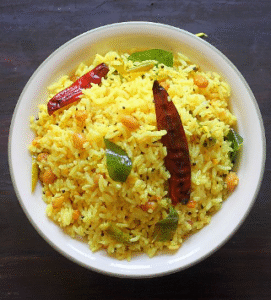Pulihora is a seasoned rice dish where cooked rice is mixed with a tangy tamarind-based paste and tempered with spices. The term “Pulihora” derives from the Telugu word “puli,” meaning sour, aptly describing the dish’s distinctive taste.

Historical Origins
The earliest documented mention of Pulihora dates back to 1010 CE, found in inscriptions from the Thanjavur temple kitchens during the Chola dynasty. This indicates that the dish has been a staple in temple cuisine for over a millennium.
Some sources suggest that variations of tamarind rice existed even earlier, possibly before the 3rd century BCE, highlighting its longstanding presence in South Indian gastronomy.
Religious and Cultural Significance
Pulihora holds a special place in religious practices, often prepared as prasadam (sacred offering) in temples across South India. Its tangy flavor and long shelf life make it ideal for distribution to devotees during festivals and special occasions.
In Andhra Pradesh, Pulihora is a customary dish during festivals like Ugadi, Varalakshmi Vratham, and Diwali. The sourness from tamarind is believed to symbolize the various flavors of life, making it a dish of both culinary and philosophical importance.
Regional Variations
While Pulihora is prevalent throughout South India, regional adaptations have led to distinct versions:
-
Andhra Pradesh: Known for its spicier take, incorporating green chilies, Guntur red chilies, and red chili powder.
-
Tamil Nadu (Puliyodarai): Features a tangier flavor with the addition of jaggery and a unique spice blend called podi.
-
Karnataka (Puliyogare): Includes a distinctive spice mix with ingredients like chana dal, urad dal, fenugreek seeds, coriander seeds, and red chilies.
-
Key Ingredients & Techniques
1. Tamarind Pulp
The soul of pulihora lies in its tamarind base. Use fresh, high-quality tamarind for a vibrant tang. Soak the tamarind in hot water, extract the pulp, and strain to remove fibers and seeds. This ensures a smooth, rich concentrate that forms the foundation of the dish.
2. Spice Blend
Aromatic spices are crucial for depth of flavor. Dry roast a mix of mustard seeds, cumin, coriander seeds, fenugreek, sesame seeds, and dried red chilies until fragrant. Grind them into a fine powder to create a homemade masala that adds complexity to the tamarind mixture.
3. Balancing Sweetness
To counterbalance the tamarind’s tartness, incorporate jaggery or sugar. Adjust the sweetness to your preference, aiming for a harmonious blend that doesn’t overpower the dish’s signature tang.
4. Tempering (Tadka)
Heat oil (preferably sesame oil for authenticity) and add mustard seeds, urad dal, chana dal, peanuts, dried red chilies, curry leaves, and a pinch of asafoetida. Fry until the ingredients are golden and aromatic. This tempering infuses the dish with a nutty crunch and enhances its overall flavor.
5. Rice Selection
Opt for short-grain rice varieties like sona masuri. Cook the rice so that each grain remains separate and fluffy. Once cooked, spread it out to cool, preventing clumping when mixed with the tamarind base.
6. Assembly
Combine the cooled rice with the prepared tamarind mixture and tempering. Mix gently to ensure even coating without breaking the rice grains. Allow the pulihora to rest for a while before serving; this resting period lets the flavors meld beautifully.
🍽 Serving Suggestions
Pulihora is traditionally served with accompaniments like papad, curd, or simple vegetable stir-fries. Its robust flavors also make it an excellent choice for travel meals or festive offerings.
Instructions
-
Cook the Rice:
-
Rinse the rice thoroughly and cook it with 2 cups of water until each grain is separate and fully cooked.
-
Spread the cooked rice on a plate to cool. Drizzle with sesame oil, sprinkle turmeric powder and salt, and mix gently. Set aside.
-
-
Prepare the Tamarind Extract:
-
Soak the tamarind in warm water for 15 minutes. Extract the juice and discard the pulp. If using tamarind paste, dilute it with water to make about ½ cup of tamarind water.
-
-
Make the Tamarind Paste:
-
In a pan, heat 1 tablespoon of oil. Add the tamarind extract, jaggery, turmeric powder, and salt. Cook on medium heat until the mixture thickens and the raw smell of tamarind disappears. Set aside.
-
-
Prepare the Tempering:
-
In another pan, heat 2 tablespoons of oil. Add mustard seeds and let them splutter.
-
Add chana dal, urad dal, and peanuts. Fry until they turn golden brown.
-
Add dried red chilies, green chilies, curry leaves, and a pinch of asafoetida. Sauté for a minute.
-
-
Combine Everything:
-
Add the prepared tamarind paste to the tempering and mix well.
-
Pour this mixture over the cooled rice and mix gently until the rice is evenly coated with the tamarind mixture.
-
-
Rest and Serve:
-
Let the pulihora sit for at least 30 minutes to allow the flavors to meld.
-
Serve at room temperature, optionally with papad or curd.
-
-
“ENJOY YOUR YUMMY PULIHORA”
